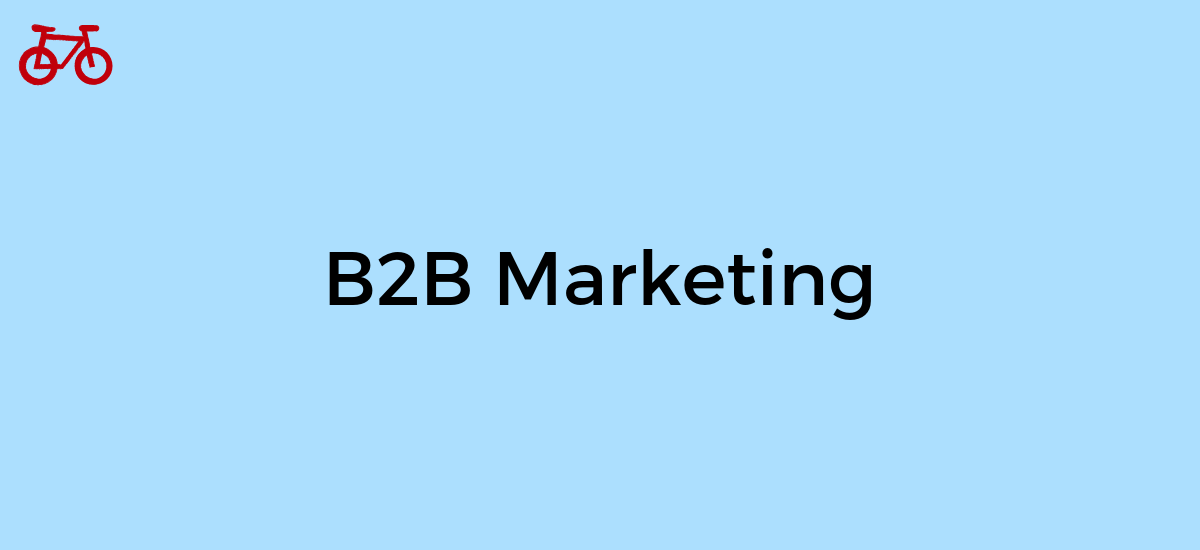Businesses consume many products. Whether it helps them manufacture their own products, resell products, or facilitate their internal processes, it is an expansive market.
This is the business to business market. Building and marketing products to other businesses. Those businesses can be one-person consultancies or Fortune 100s. Each size business has specific needs.
That is why we need to understand marketing as it relates to the business to business market. That’s why we need to discuss business to business marketing.
Here, we are going to provide an overview of business to business marketing and some of the considerations and strategies you should be familiar with.
What is Business to Business Marketing?
Business to business marketing, or simply B2B marketing, is the process of marketing and selling products to businesses. These are products and services that allow companies to create, build, manufacture, and market their own products. This can also include the resale of products.
B2B marketing is not difficult, but it’s complex. Often, the purchasers of products and the users of products are different. Which is why B2B marketing, as a concept, differs from the alternative of B2C marketing.
B2B marketing plays an important role in understanding marketing. Marketers can cross between B2B marketing and B2C marketing during their careers, but they tend to focus on one particular area.
To further understand B2B marketing, we will discuss some of its characteristics, frameworks, strategies, and the B2B marketing plan.
Characteristics of B2B Marketing
There are many reasons why B2B marketing has to be viewed as its own concept. Its characteristics require a different approach, with different tools, tactics, and strategies. Ultimately, products are different. They do not necessarily get used by an end user. And, the purchaser can be different than the user.
All this contributes to a different dynamic than B2C marketing. So, we need to take a look at some of the characteristics to understand how to execute our B2B marketing strategies. Here are some of the characteristics of B2B marketing.
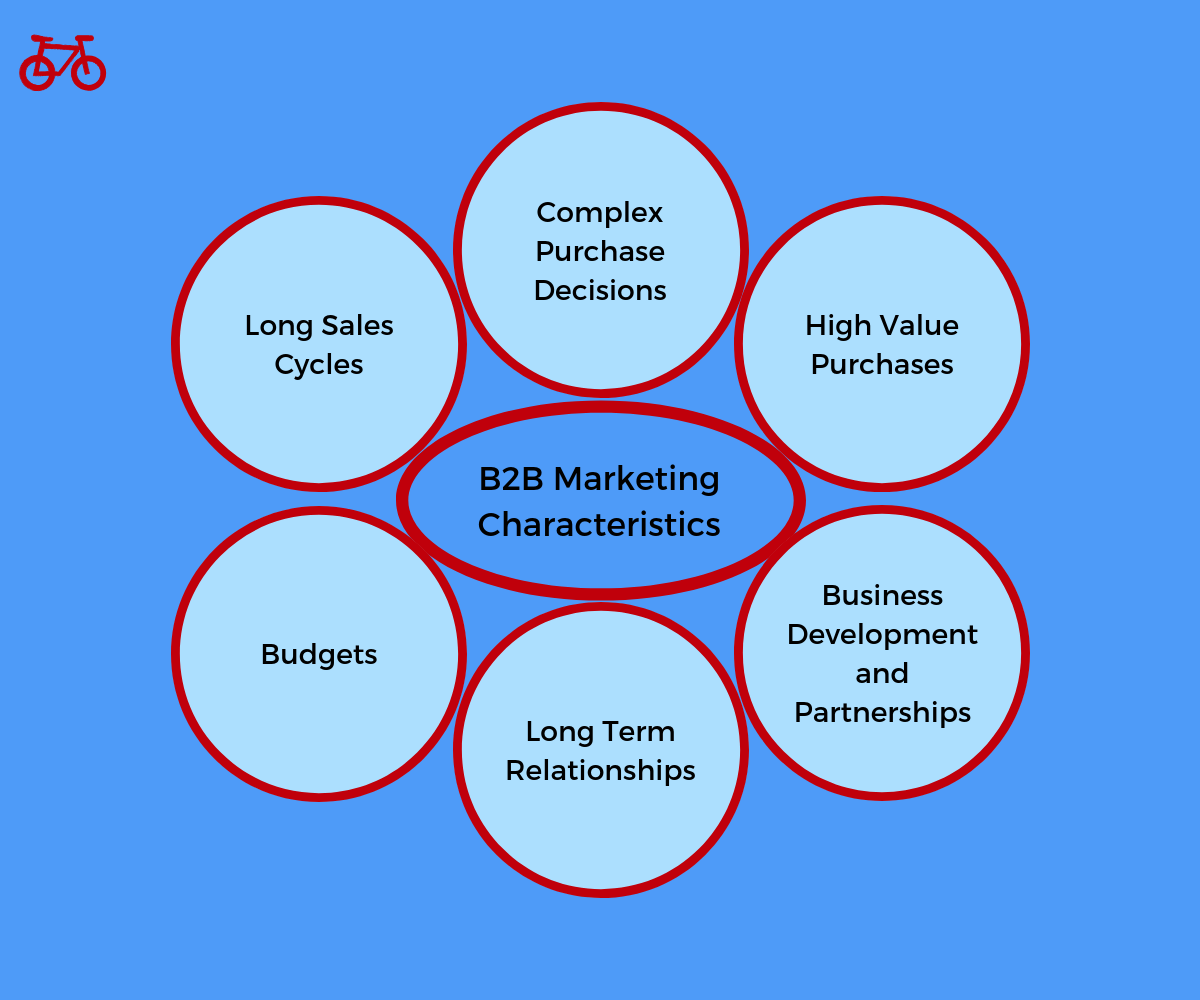
Long Sales Cycles
B2B purchases can take a long time. The sales cycle can be as short as days. Or, it can take months. This all depends on the size of the companies involved, the value of the deal, and many other factors.
But, a long sales cycle is a key characteristic of B2B marketing. Time is a large factor that needs to be budgeted for. The marketing process and strategy needs to match the time that is required to close sales.
Complex Purchase Decisions
Another characteristic, which contributes to the long sales cycle discussion, is the fact that the purchase decisions are complex. There are usually many stakeholders and buy-in has to come from multiple levels within an organization.
Thus, your B2B marketing infrastructure has to be robust enough to support the complex decision-making process.
High Value Purchases
One reason the purchase process is complex is the purchase values tend to be high. If we are comparing them to consumer purchases, they are significantly higher. Thus, the long sales cycle and complex purchase decisions reflect the value of the purchases.
But, high value is not just cost, in terms of price. It is also represented in the required implementation and the process changes that are required within an organization. All of this contributes to the fact that B2B marketing has to consider that purchase values are high.
Budgets
Another key characteristic of marketing to B2B customers is the customers budgeting process. That means prices need to align within what a budget allows. Also, there is a time factor to budgets. Meaning, purchases may be delayed due to budget constraints, budget approvals, and various other budgeting factors.
Thus, the marketing team needs to understand the target markets budgeting process. The processes a company employs to market to B2B customers has to be able to handle a budgeting process.
Long Term Relationships
A luxury that B2B marketers have is the ability to create long term relationships with customers. Purchases tend to require significant decision making. Thus, customers tend to stay longer with companies. This increased length means that B2B marketers don’t just market to prospective customers, they also have to market to existing customers. Both for retaining them and increasing the revenue they do with the company.
A nice characteristic of B2B customers is the increased length of time they will stay with a company. Ultimately, this length can shape a lot of decisions a company will make regarding how it acquires customers and markets to existing customers.
Business Development and Partnerships
Another characteristic of B2B marketing is the concept of business development and partnerships. This is a concept where there are many ways to build pipelines to acquire customers. The buying process is extremely flexible and B2B customers purchase in many different ways.
Thus, creating partnerships and working with business development provide a level of flexibility in B2B marketing that does not exist in other forms.
The characteristics above are just a few that B2B marketers have to consider. They shape marketing strategy and provide the framework that marketers can work with. These are some of the characteristics that differentiate B2B marketing.
The B2B Marketing Framework
The next thing to understand within business to business marketing is the B2B marketing framework. The B2B marketing framework is the key components we have to work with in our marketing strategy. These are things like generating awareness and nurturing leads.
There is a common framework we have to work with. This framework is modeled to work with the particular characteristics of B2B marketing. The following is the typical framework that B2B marketers will use to create a marketing strategy.
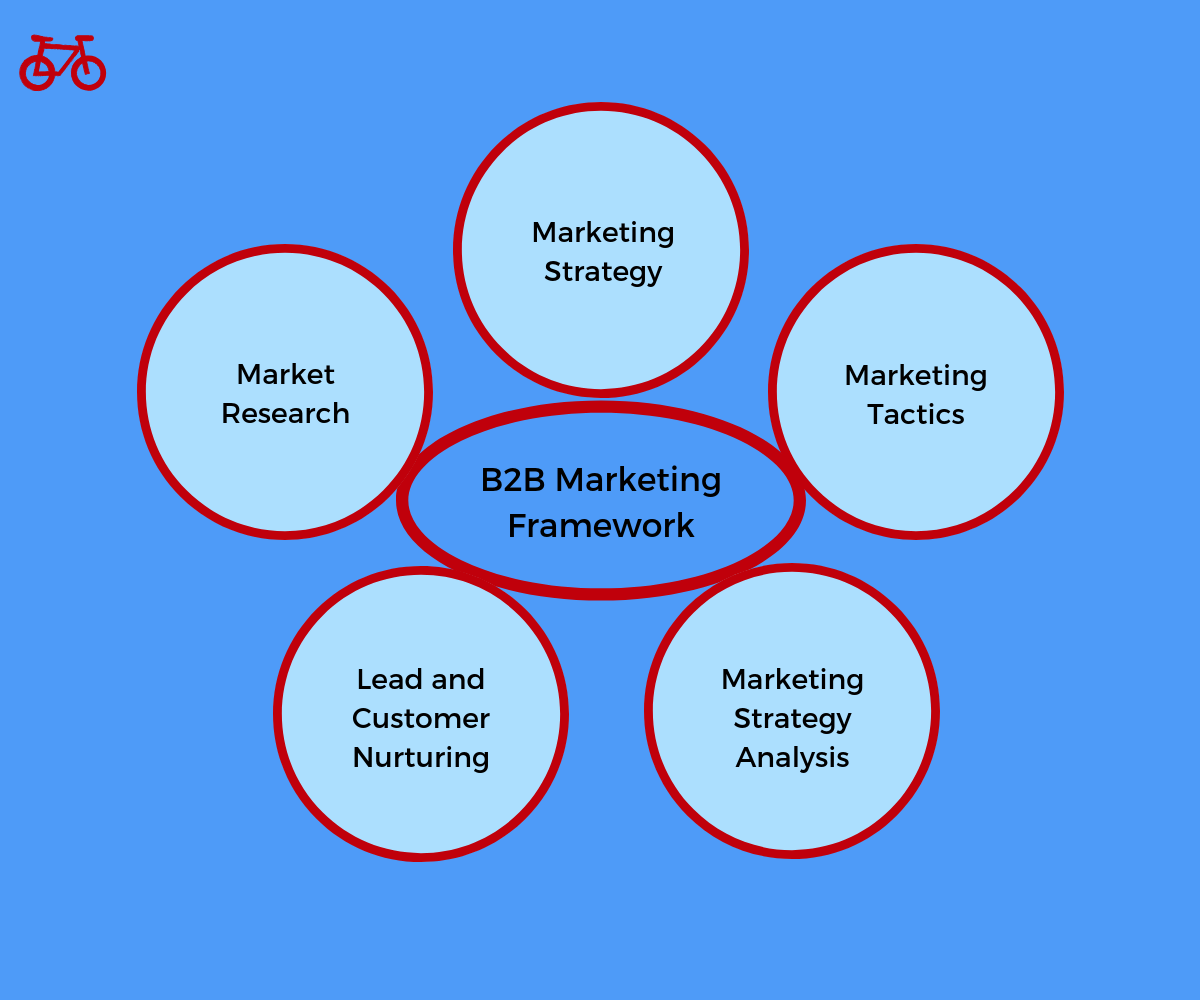
Market Research
The first component in the marketing framework is research. This becomes the foundation of our marketing efforts.
We need to understand the market. Both in terms of who our target audience is and the competitive landscape. This provides us the ability to make our messaging and positioning relevant to our audience. Also, it’s what differentiates us in the marketplace.
Research is a foundational component to our B2B marketing framework.
Marketing Strategy
The next area we need to take a look at is determining the marketing strategy or strategies we will use. You will need to define your overall marketing strategy. Then, you choose the tactical strategies you will use.
Strategy ultimately becomes hypothesis generation. Meaning, defining a strategy you think will work. Then, execute and test. It needs to be flexible enough to make changes. Marketing strategy should be a definition of what can possibly generate success. Then, continually test and improve to improve results.
Marketing Tactics
The next component of our framework, after we have determined our strategies, we will define the marketing tactics we will use. The tactics are the individual aspects of the strategies we employ.
For example, if we are going to use content marketing as a strategy, then our tactics would be whether we blog, write eBooks, Whitepapers, or use webinars.
This will largely depend on the audience, your company’s capabilities, and budget. Defining the tactics provides a well-rounded marketing framework.
Lead and Customer Nurturing
A critical component to the business to business marketing framework is how you will nurture your leads and customers. As we discussed earlier, the sales cycles can be long and complex. Thus, how you manage prospects and customers through this time period can determine whether or not you are successful.
Building a nurturing framework that scales, can be automated, and replicated is an important component to address. It is all about how you move prospects through the sales funnel.
Marketing Strategy Analysis
The last component of the framework is building a feedback loop into the system. A system where you can track, manage, and analyze the success of your marketing efforts. Marketing strategy and execution is not a set it and forget it mechanism.
The market will change, shift, and adjust. Thus, our marketing strategy should be able to do the same. And it should be able to do this based on data.
These are some of the essential components to a B2B marketing framework. To use this framework, it is essentially a guide for making educated decisions about your marketing. Building a foundation that is flexible and sound. Start with this and become as detailed as your business needs.
B2B Marketing Strategies
Once we have established our marketing framework, we can move onto the strategies we would like to implement. These are the overarching strategies we will choose. We choose them based on our opinions about marketing and our market. Then, we use data to determine which strategies work for us.
There are many marketing strategies we can choose from. Depending on how you classify a strategy, it can also determine what we choose. We are going to cover three of the more common strategies being discussed at the moment. These are not the only you have to choose from. But, they are broad enough to build a marketing ideology around.
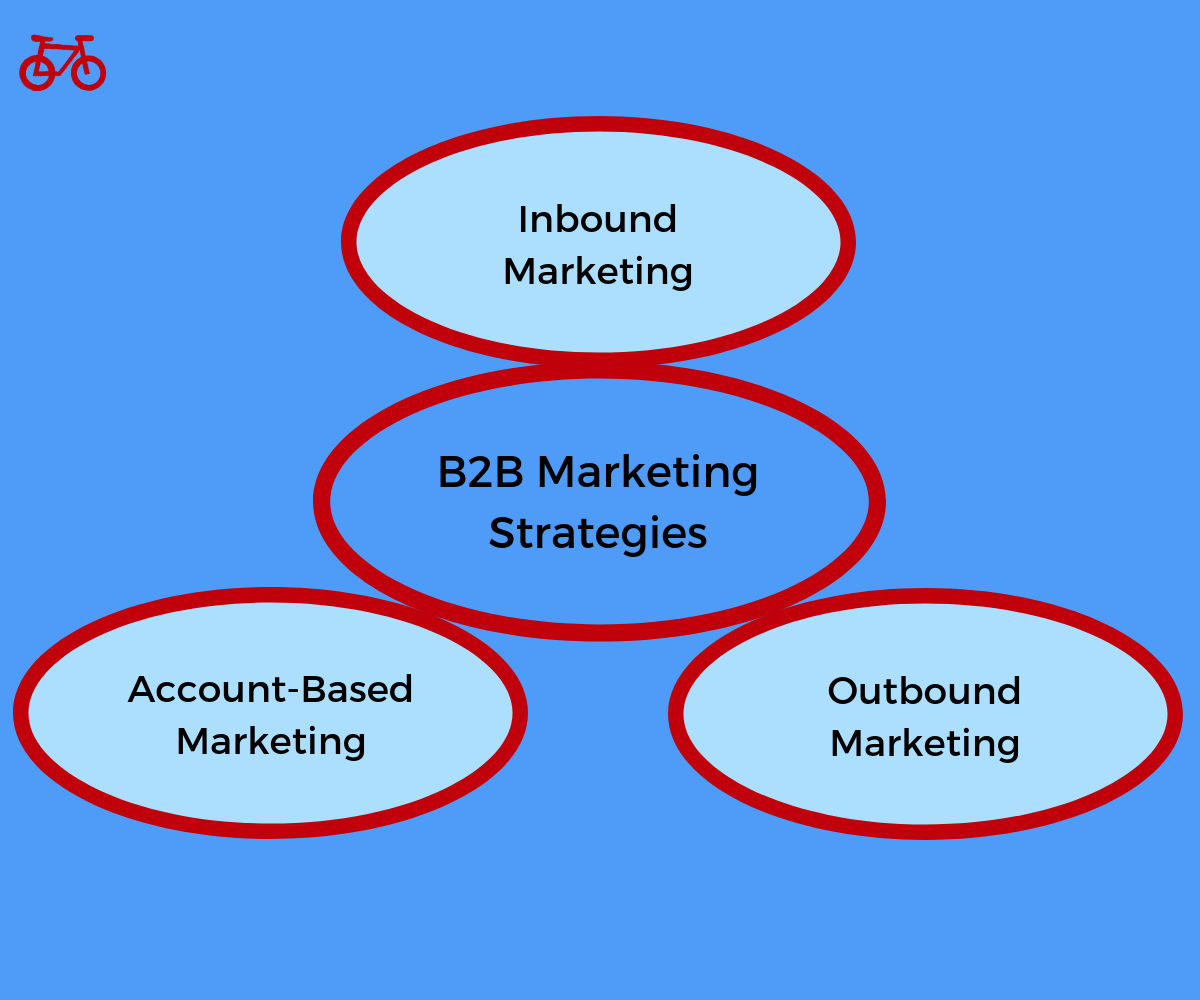
Inbound Marketing
Inbound marketing is a modern pull marketing strategy. It is about creating demand for your products through awareness. Then, nurturing those contacts and converting them to customers.
It is an effective strategy and works well for B2B marketing.
Account Based Marketing
Account based marketing is another form of pull marketing. But, this is creating demand for your product within specific, strategic accounts. It fosters high sales and marketing alignment. It can be quite effective.
Account based marketing is highly suited for large, enterprise level companies targeting enterprise level customers.
Outbound Marketing
Outbound marketing is your push marketing strategy. This is going to be outbound sales, outbound emailing, outbound direct mailing, and heavy advertising. These are not all the characteristics, but a few key ones to understand the strategy.
It is effective for big brands with large budgets. Also, it is effective for short timelines.
These are just a few key strategies that are trendy at the moment. They are all effective when used for their strengths. Understanding the strategy and why it would be used is a critical first step. Then, align it with your marketing framework.
Components of a B2B Marketing Plan
Once we have established our framework and strategies, it is time to create the marketing plan. This is going to be our detailed plan to execute our marketing. Planning might be time consuming and not the most fun activity, it is critical for effective marketing.
When planning your marketing, there are key components to address in the plan. These are similar to a business pan and are well established. The following are key components to a B2B marketing plan.
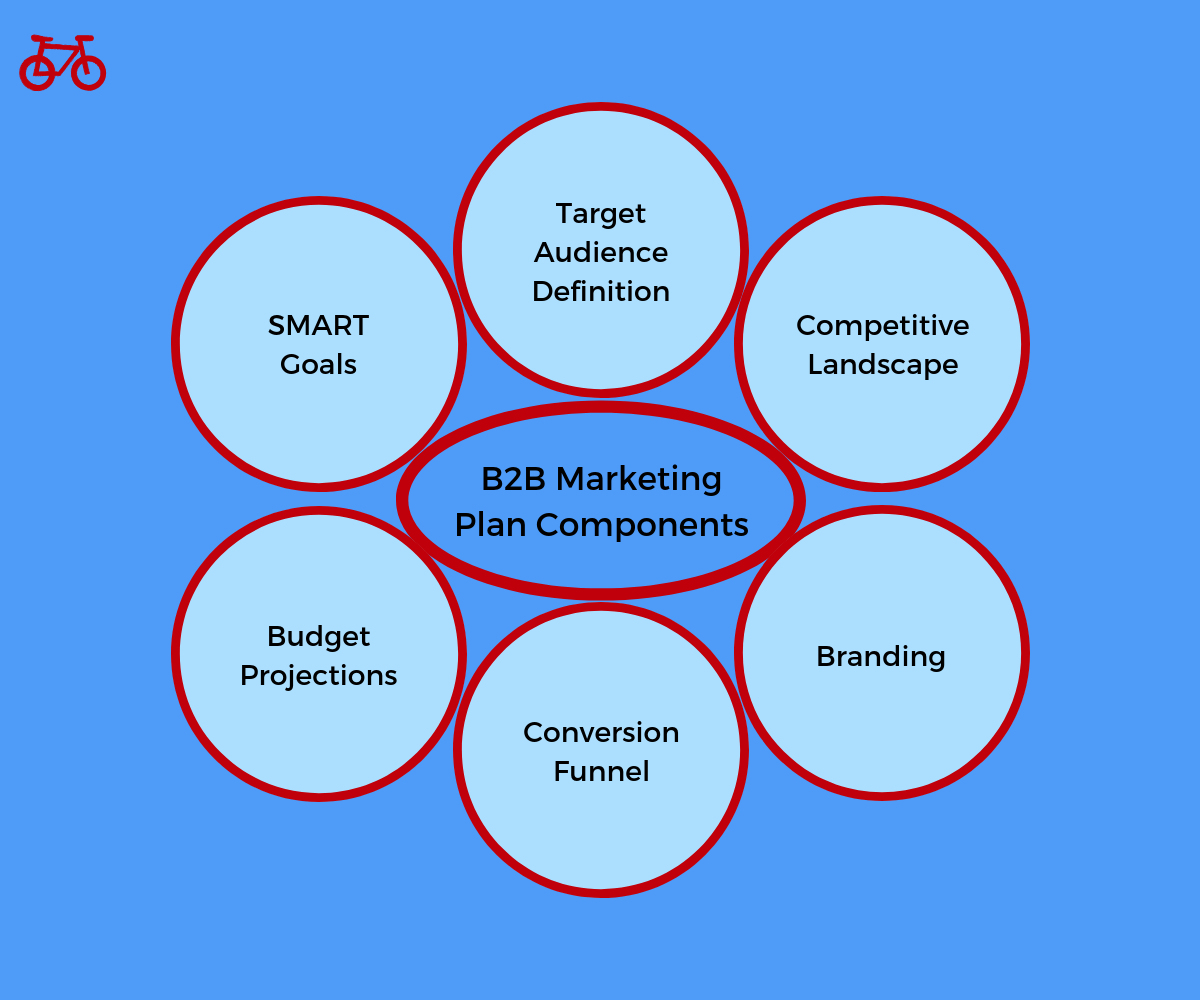
SMART Goals
The first component is goal setting. We need to set SMART goals prior to doing any further marketing planning. This will determine everything else we do. Everything from the size market we need to target and the budgets we need to generate our desired results.
Once we set our SMART goals, we can build the rest of the plan.
Target Audience Definition
The next component is defining our target audience. This is building our ideal customers and segmenting those ideal customers. During audience definition, we want to identify all potential stakeholders in a purchase decision. This way we have a comprehensive understanding of our market.
Understanding and defining the audience will determine how we attract and convert them. This is an additional component we will need to plan for.
Competitive Landscape
As we perform market research, we want to know our competitors. We want to know who they are and what they are doing. This way we can strive to improve our marketing, our products, and create a message of differentiation.
Budget Projections
The next component is what budgets we will need to execute our plan. If we do not budget correctly, we could overspend on acquisition. Which can occur if we do not understand our costs. Incorrect budgeting can lead us to missing our financial goals.
Budget projects are how we ensure we have the resources necessary to execute our marketing plan.
Conversion Funnel
The next area is defining our conversion funnel. Although at the planning stage we don’t always know or understand the specifics, we need define it the best we can. This will help strategize how much it costs to acquire a customer. Also, it will determine what tactics we use to attract and convert them.
Branding
The last area we want to address in our marketing plan is our branding. This is creating a branding and style guide. Including our messaging, positioning, and the visual representation of our company. We want a definition so we can create consistency in the market.
This is an overview of some of the key components to a B2B marketing plan. There are many nuances to build into the marketing plan. Also, marketing planning is a critical process that requires a lot of research. But, a great plan is necessary to have a roadmap for execution.
B2B marketing requires a specific set of strategies. It operates on long sales cycles and complex purchasing decisions. Thus, we need to understand this process and create plans and strategies that reflect it. This is an overview to understanding some of the essential considerations in B2B marketing.
